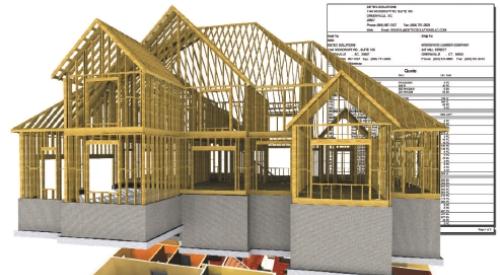|
When Cornerstone Communities opened its luxury condominium project, Terrazza, for pre-sales in April 2007, there were no model homes and no on-site amenities. Instead, Cornerstone used virtual tours to show what the homes and community would look like.
"We knew we were not going to have anything for people to see for 14 months," says Brad Clason, a Coatesville, Pa., marketing consultant who worked on the project. "Also, we were in a suburban market where no one had done condominiums of any sort in a long time."
 |
| Can you tell this is a virtual model? Virtual tours are an effective tool for selling large multifamily projects before you break ground. Image: Aareas Interactive |
Cornerstone sold 45 homes before opening physical models. "Most important, our initial success was such that the lender gave us the go-ahead on the second building within six weeks," Clason says.
Virtual Solutions, based in Bonita Springs, Fla., supplied the 3-D images and animation for approximately $85,000. "They did a real nice job of furnishing the virtual models appropriately and even showing actual views outside the windows," says David Della Porta, president of Cornerstone Communities in Villanova, Pa. Clason notes that in today's market, a developer could reproduce a similar virtual portfolio at more competitive costs.
Sarah Peck, principal of Progressive Housing Ventures in Malvern, Pa., says the authenticity of virtual tours gave her a big head start on sales at the Green Street Mews townhome development. Every detail, from the artwork to the silverware on the dining room table, was scanned in. The furniture came from retail stores where local buyers actually shopped. Even the views were replicated.
"I sold half the job from virtual tours of two plans," says Peck. "By the time the model home opened, the rest of that first building of 10 units was sold and people were already moved in."
Peck used Design East, Inc. of Medford, N.J., and Builders Design in Gaithersburg, Md., to get two different looks. The interior design firms thought through the buyer profile, space-planned the furniture and created a lighting plan for each model. "Not only could the buyer see the finishes exactly as we were offering them, they could also play with their furnishings, using bird's-eye views and snapshots of rooms from different angles." The cost was approximately $32,000, including the interior design fees. DieselHorse Studios of Moorestown, N.J., provided the 3-D renderings and animation.
Virtual tours alone won't sell houses; they must be integrated into part of a builder's sales and marketing campaign to have the maximum impact. Clason says that although they contributed to the success of Terrazza, the key was to use them as part of a suite of sales-center tools, including a large scale model; touch-screens that helped buyers choose their elevations and floor plans; and virtual tours of the clubhouse and five models.
 |
 |
| The play of light and shadow brings a rooftop terrace to life. | The level of realism in virtual tours is so high, you can almost hear leaves rustling. Images by Aareas Interactive |
Multiple uses
Today, builders use virtual tours during the entitlement process; for large master-planned communities and multifamily projects when there is a long lead time between pre-sales and construction; and to iron out design problems before any dirt is turned (see sidebar). In redevelopment areas where the entire neighborhood is undergoing change, virtual reality can show prospective buyers what a project is going to look like in two, five and 10 years.
In the San Francisco Bay area, virtual tours are required for entitlement, says Chip Pierson, principal and general manager of Dahlin Group Architecture Planning in Pleasanton, Calif. Dahlin's Digital Imaging Studio creates drive-throughs, flyovers and model tours for builders to show at the design review for the planning commission.
Lennar Communities' Urban Division, based in San Francisco, has created virtual tours for urban high-rise projects where purchases are made as much as two years in advance. "You can show the specific building and the coffee shop on the corner, the park down the street, the museum. The buyer gets this wonderful experience before anything has even come out of the ground," says Lynn Bell, director of sales.
Virtual reality isn't a slam dunk in every situation. Bell says the virtual tours for The BLU, a high-rise in downtown San Francisco, did create some pent-up interest. But market fluctuations forced Lennar to accelerate construction to accommodate buyers who wanted to close in 45 to 60 days. "For one of our next projects, a large master-planned community, it's going to be more important for us to use VR to tell our story," says Bell.
"If you're doing single-family housing and you're going to have models ready three or four months after you open, the cost probably isn't worth it. But when you want to portray a lifestyle or amenities that won't be visible to prospects for 12, 18 or 24 months, this is a great technology," Clason says, adding that traditional neighborhood developments, where it's hard to visualize the curb appeal until a few dozen homes are built, greatly benefit from virtual-reality technology.
Marketing consultant Elise Platt, president of E.A. Platt & Co. in New York, can testify that virtual reality makes an unbuilt community come alive. "With the banks requiring so many more pre-sales, I don't see how builders can avoid using it," Platt says. And it's to the builder's advantage to do virtual reality right, even if it costs more. "You can buy [stock] virtual programs for $5,000 a tour, but that doesn't necessarily take you where you want to go, and it can even be distracting."
Platt and nationally recognized interior designer Lita Dirks of Greenwood Village, Colo., created a virtual library using catalogs from Pottery Barn, Crate and Barrel, Ethan Allen and other furniture retailers. "Lita does our model presentation before doing the virtuals, then scans in the fabrics, furnishings and accessories she has chosen. When buyers walk through the physical models 10 months later, the homes look really familiar to them," Platt says.
There's no question that virtual technology, which has been around for at least 20 years, has become more sophisticated. "When we first started in 1991, virtual was very time-consuming," says Frank Guido, president and CEO of Aareas Interactive, a 3-D rendering and animation company based in Toronto. "There were very few companies doing it ,and the quality was very Nintendo-graphic-ish."
Today the process is much faster and more photo-realistic. Thanks to more powerful hardware and software, it's possible to make flags ripple and trees sway in the background, Guido says.
Virtual technology creates a sense of anticipation that can only be equaled by an actual site visit. Viewers "drive" through the community's virtual entrance and around the neighborhood, then fly over and inside the clubhouse and other amenities. Video footage of people using the facilities can be incorporated to convey lifestyle.
The Marketing Directors, a New York residential real-estate sales and marketing firm, has found that virtual tours are most effective on social networking sites such as Facebook and YouTube. "We also embed them in e-mails to Realtors and prospective buyers," says Martin Brady, vice president of sales. "They have movement and excitement. We get more calls and click-throughs when we put a virtual tour or 360-degree panoramic tour in the link than we do with a static picture."
Brady says the tours have probably doubled broker co-op activity. "I have a condominium building in Hoboken, N.J., which is still not completed. We're doing it in presale from a very small sales office without models. Through the virtual tours we've been able to sell 11 of the 16 units in about four months, which really is tremendous in this marketplace."
Tridel, a large high-rise condominium developer in Toronto, has made virtual tours an integral part of its sales presentations for more than 10 years. There are no floor plans on the walls of their sales offices — just flat-screen TVs.
"We presell the vast majority of our product before we start construction," says Jim Ritchie, senior vice president of Tridel. "VR enables consumers to understand large, complex architectural designs, and the better they understand it, the better the chances that they'll purchase a home."
|












